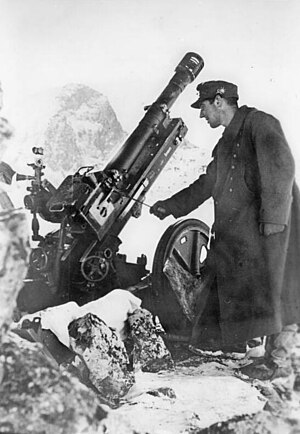7.5cm Gebirgsgeschütz 36
| 7.5 cm Gebirgsgeschütz 36 | |
|---|---|

A Gebirgskanone in use in the Causacus, January 1943
|
|
| Type | Mountain gun |
| Place of origin | Nazi Germany |
| Service history | |
| In service | 1938-45 |
| Used by | Nazi Germany |
| Wars | Second World War |
| Production history | |
| Designer | Rheinmetall |
| Designed | 1935–38 |
| Manufacturer | Rheinmetall |
| Produced | 1938–45 |
| No. built | 1,193+ |
| Specifications | |
| Weight | 750 kg (1,650 lb) |
| Length | 1.45 m (4 ft 9 in) (overall length) |
| Crew | Five |
|
|
|
| Shell | 75×130 mm. R (separate-loading, cased charge) |
| Shell weight | 5.75 kg (12.7 lb) |
| Caliber | 75 millimetres (3.0 in) |
| Breech | horizontal sliding block |
| Carriage | split trail |
| Elevation | -2° to +70° |
| Traverse | 40° |
| Rate of fire | 6-8 rpm |
| Muzzle velocity | 475 m/s (1,560 ft/s) |
| Maximum firing range | 9,250 m (10,120 yd) |
The 7.5 cm Gebirgsgeschütz 36 (7.5 cm GebG 36) was a 7.5 cm (3.0 in) German mountain gun used during World War II. At least 1,193 were built between 1938 and 1945. It was the standard light gun of the German mountain divisions, both Army and Waffen-SS, during World War II.
The 7.5 cm GebG 36 was designed by Rheinmetall to meet an Army requirement for a 7.5 cm howitzer to serve in the mountain divisions (Gebirgs Divisionen) and replace the World War I-era mountain guns still in service such as the Austro-Hungarian 7.5 cm Gebirgskanone 15. Production began in 1938 although exactly how many were produced that year is unknown. Some 1,193 were built between 1939–45.
The design of the 7.5 cm GebG 36 was relatively conventional in regard to the gun itself, with its standard German horizontal sliding breech block and muzzle brake. To maximize its ability to fire at high-angles, it was given rear trunnions to lengthen the distance between the breech and the ground, although springs became necessary to balance the muzzle preponderance. Furthermore, it used the a variable recoil system that shortened the recoil as the elevation increased. The breech was uncommonly massive as it incorporated a transport joint to allow it to be separated from the barrel.
The spades at the end of the split trail legs were removable. Generally it used light-alloy disc wheels with rubber rims, but early guns had wooden-spoked wheels. No shield was fitted to save weight. It could be towed in one load or broken down into eight pack-loads to be carried by mule or horse. It weighed 750 kg (1,650 lb).
Because of its lightness the 7.5 cm GebG 36 would jump when fired at low angles as the recoil forces would force the gun's trail spades to act as a fulcrum and lever the wheels upwards. In fact Charge 5, the largest propellant increment, was forbidden to be fired at angles under 15° because the gun would jump excessively. Firing at higher angles was perfectly safe as the ground absorbed any residual recoil forces not absorbed by the recoil system.
...
Wikipedia
